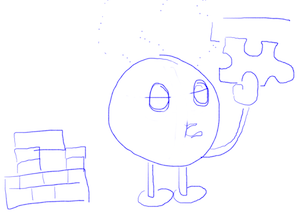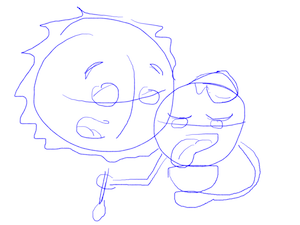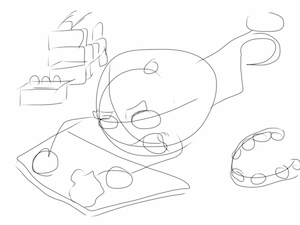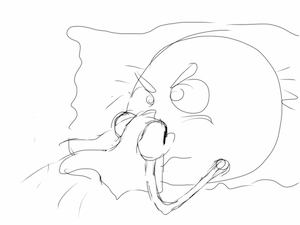Intro
See the last post for the first part of the guide.
Process
Pick a moralPick a themeLayout the storyStoryboard the scenes- Flesh out the story
- Refine
Fleshing out the story
Once you have the rough storyboard, add more scenes in between each of the scenes you have. You may also add one additional scene before the beginning and after the end, but be wary of this, as it may draw the story out unnecessarily. After visualizing and writing down a couple sentences for each scene, repeat the process for blocking out the scene including lettering.
You may repeat this process as many times as you like, but focus on telling the story and describing important scenes. Don’t feel the need to just add filler. As you add more scenes, pick and choose locations to add them. If you find yourself adding many scenes near the end, consider how to merge scenes. Don’t fall into the trap of narcissistic writing, just focus on telling a tight, entertaining story.
Secondary Scene: The moon hangs out with the sun.
Primary Scene: The moon runs around the heavens. (Beginning)
Secondary Scene: The moon plays with building blocks
Secondary Scene: The moon plays with puzzle pieces
Secondary Scene: The moon mommy feeds the moon a meal of star flakes.
Primary Scene: The moon throws its food out, which become stars. (Middle?)
Secondary Scene: The moon mommy scolds the moon and tells him he needs to eat to stay strong.
Secondary Scene: The moon gets weaker and more dim.
Primary Scene: The moon goes hungry and stops speaking. (End)
Secondary Scene: Stars drag the moon around playfully.
Edited to merge scenes:
MERGED Primary Scene: The moon runs around the heavens with the sun.
(Beginning)
MERGED Secondary Scene: The moon plays with building blocks and puzzle pieces.
MERGED Secondary Scene: The moon mommy feeds the moon a meal of star flakes, cautioning that he should eat to stay strong.
Primary Scene: The moon throws its food out, which become stars. (Middle?)
Secondary Scene: The moon gets weaker and more dim.
MERGED Primary Scene: The moon goes hungry and is carried around by stars (End)
As you create new scenes and storyboard, you may want to revise other scenes. For example, you may notice when laying out the scene that there is a more dynamic or entertaining scene that you want to portray.
Here are my new scenes:
MERGED Secondary Scene: The moon plays with building blocks and puzzle pieces.
MERGED Secondary Scene: The moon mommy feeds the moon a meal of star flakes, cautioning that he should eat to stay strong.
Refinement
Once you have settled on your scenes, you’ll work to refine them. Add some more detail to each scene, including rough facial expressions, motion lines, more background and foreground objects. Experiment with the lettering. If you overlay it onto the scene, it may be more engrossing, but harder to read. You could instead add captions to each scene. This is also where you start to work on wording. Focus on short, concise sentences.
This step is where your book will really shine. It’s best to add details little by little to each scene, focusing on the primary scenes first. Working this way will bring you to the end state little bit little, but give you a greater sense of completion along each step along the way.
MERGED Primary Scene: The moon runs around the heavens with the sun. (Beginning)
MERGED Secondary Scene: The moon plays with building blocks and puzzle pieces.
MERGED Secondary Scene: The moon mommy feeds the moon a meal of star flakes, cautioning that he should eat to stay strong. Primary Scene: The moon throws its food out, which become stars. (Middle?)
Secondary Scene: The moon gets weaker and more dim.
MERGED Primary Scene: The moon goes hungry and is carried around by stars (End)
Next
In the next installment, I’ll discuss the remaining steps in the framework, and show the first full draft of the WIP. I’ll also discuss further refinement.



